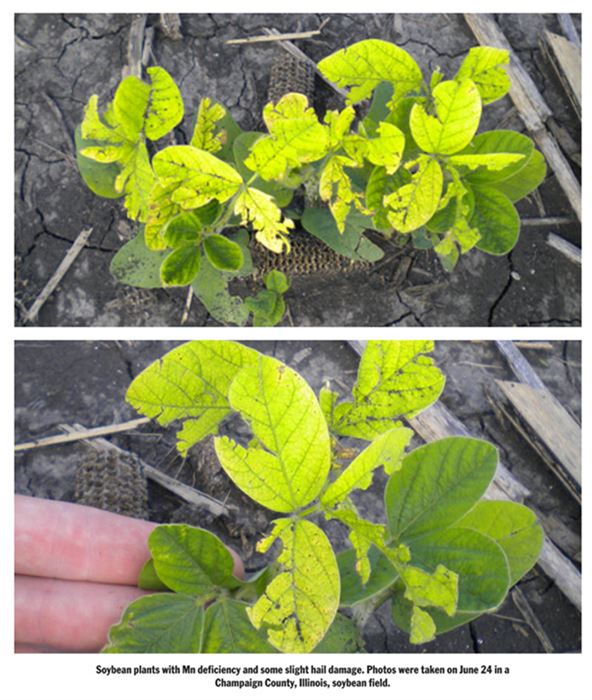Yellow Soybeans In High pH Soils: Sign Of Mn Deficiency
Statewide soybean acres are 88% planted, 76% emerged as of June 28, and the earliest planted soybeans (1%) are starting to flower as a result of last week's high nighttime temperatures. High temperatures coupled with adequate moisture have provided very rapid crop growth and development. As crops grow rapidly, they also increase the rate of uptake of nutrients from the soil. This increase can create a deficiency of nutrients because the soil cannot release them fast enough to supply crop needs. Nutrient deficiencies that develop under these high-demand conditions typically occur in soils with marginal levels of the nutrient in question. So periods of rapid growth are a good time to inspect your crops for deficiencies of nutrients for which a reliable soil test is not available, such as micronutrients.

Manganese (Mn) is one of the micronutrients receiving attention in recent years. Concerns of Mn deficiency in soybeans have increased in part due to reports indicating reduced Mn availability following postemergence glyphosate applications. Many studies are being conducted on this issue, with mixed results. Whether or not Mn deficiencies are related to glyphosate applications, Mn deficiency has been observed in some fields, typically in soils with high organic matter, high pH, or poor drainage.
Since Mn is not easily translocated in the plant, deficiency symptoms appear in the newest developed leaves. The common symptoms include chlorosis or "yellowing" between the veins, while older leaves will still appear darker green. As the severity of deficiency increases, the dark green veins become lighter in color. Other symptoms include stunted growth, leaf drop, and reduced flowering.
If you have observed past Mn deficiencies in a field when either rapid growth was occurring or growing conditions were not favorable for nutrient uptake (a wet, cool spring), it is likely that Mn soil levels are marginal to low. If this is the first time you have seen a deficiency, it is important, along with having a tissue test done, to evaluate root damage, soil compaction, and other factors that might have reduced the crop's ability to take up nutrients.
Though soil tests for micronutrients (including Mn) are not very reliable, a plant tissue test is a good way to determine Mn availability. The best time for collecting plant tissue for analysis is just after flowering begins (R1 developmental stage). The typical recommendation is to collect the upper fully developed trifoliate and petiole, but it is always recommended to find out what sampling technique is used by the lab doing the analysis. While most soybeans are not yet at this stage, waiting until then can be important to give the plant a chance to grow out of the deficiency if the problem was induced by other factors. If the deficiency is truly caused by low Mn levels in the soil, tissue samples at R1 development stage would indicate the need to correct the problem.
Mn levels in the soil can be difficult to correct, and changing the soil level is usually not the desired approach to fixing the situation. In some research trials, starter fertilizer combinations with Mn and sulfur in a 2-by-2-inch band off the row has been effective at alleviating the problem by lowering the pH concentration near the immediate primary soybean root. However, once the symptoms appear in a soybean crop, the best solution is to apply foliar Mn fertilizer. The best recommendation is to apply 1 to 2 pounds of Mn per acre as manganese sulfate (MnSO4), as soon as the symptoms appear or 7 to 10 days after a glyphosate application. Reapply at R1 and R3 as necessary depending on the severity of the problem. If Mn is applied as a tank-mix partner with glyphosate, the efficacy of both the glyphosate and the Mn may be reduced. However, if this is the desired approach, a chelated form of Mn (Mn-EDTA) should be used and the rates should be reduced to 0.1 to 0.25 pound Mn per acre. Moreover, when the solution is mixed, the best mixing order should be 1) ammonium sulfate, 2) glyphosate, and 3) Mn-EDTA. Of course, read and follow the label directions for the specific products you are using. Δ